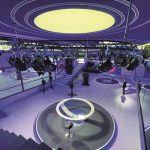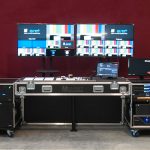This season the broadcasting of all La Liga games will see an improvement, as the number of cameras in the stadiums will be increased and will include more super slow-motion cameras in all broadcasts, such as the Steady Cam.
The 2019/20 season which began on August 16, will see La Liga consolidate its position as a competition which promises a seamless broadcasting experience for viewers.
Addressing the press at the Real Madrid Cafe in JBR, Maite Ventura, Managing Director, La Liga, MENA announced the new players, stadiums, sponsors and technology for the La Liga Santander 2019/20 Competition.
The 20 competing clubs will spend ten months fighting to win the title to qualify for European competitions or even avoid relegation.
Commenting on the broadcasting efforts of La Liga for this season, Ventura revealed that the company has sought out new technologies in order to give the best representation of La Liga on screens.
Ventura added that in order to support the introduction of VAR, La Liga will install goal-line cameras in all the stadiums. These will also support the television broadcasts.
La Liga has invested heavily in broadcasting technology in order to provide a 360-degree viewing experience for fans.
The company will install wide-angle/fisheye cameras at the highest points in each La Liga Santander stadium. This shot will provide an aesthetic view of the pitches and serve to support the pre- and post-match programmes for all broadcasters with rights.
Since the 2017/18 season, the analysts of all of the teams have had access to a camera which offers a wide-angle view of the game, providing the ideal panoramic view to analyse the tactical development of the match.
This signal will be incorporated into television broadcasts and be used to incorporate graphics which explain the tactical formations and other interesting aspects of the matches to the viewers.
In the leadup to games, broadcasting will be through DSLR cameras, which offer a cinematic aesthetic and will bring added action to La Liga games. 11 La Liga stadiums now have this technology, with Eibar and Real Sociedad the latest clubs to install aerial cameras.
Additionally, two new stadiums, Benito Villamarin (Real Betis) and Reale Seguros Stadium (Real Sociedad) – join San Mames (Athletic Club), Mestalla (Valencia CF), Camp Nou (FC Barcelona), Santiago Bernabeu (Real Madrid), Ramon Sanchez-Pizjuan (Sevilla FC) and Wanda Metropolitano (Atletico de Madrid) in offering 360-degree replay technology.
This season the broadcasting of all La Liga games will see an improvement, as the number of cameras in the stadiums will be increased and will include more super slow-motion cameras in all broadcasts, such as the Steady Cam.
To enable seamless sound quality, La Liga states that they will continue to incorporate technology such as Dolby Atmos and LAWO, the latter of which uses tracking data to give viewers more realistic sound from live matches.
Additionally, every matchday, two games will be broadcast in 4K.
The HDR system promises greater contrast and brightness to the colours from the broadcast. The 4K system is simulcast with HD production.
“La Liga will improve all of its broadcasts by adding new technology when it becomes available so that viewers can enjoy more detail and quality, thus improving their overall entertainment experience,” the company said in a statement.
La Liga matches will also see the employment of Video Assistant Referee like last season. This system is implemented to provide technical assistance to referees out on the pitch using the images from the television cameras installed in the stadiums. Operative in La Liga since the 2018-19 season, VAR has ensured that better, more consistent decisions are taken across the league.
VAR works with a team of three professional La Liga Santander referees who work in a room called the VOR (Video Operation Room), where they receive the television signal taken from each stadium. The signal comes from different angles and cameras. The VAR referees are connected to the main referee via radio which they use to communicate their decisions.
The introduction of VAR has benefited La Liga, its clubs and players, significantly, the company said. There were 121 VAR interventions across the 380 games played in La Liga Santander 2018-19. 9.5% of all goals scored were ratified by VAR. The use of VAR improved the ‘correct decision rate’ from 91.50% to 96.92%.
Players acknowledged that better decisions are now being taken; registered in-game protests from players to officials fell by 17.3% compared to the 2017-18 season, when VAR was not in use. VAR’s success in La Liga has not gone unnoticed, with the Premier League to follow suit by introducing it in 2019-20.
















































































